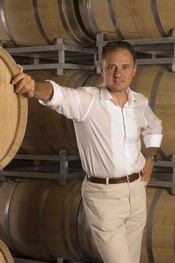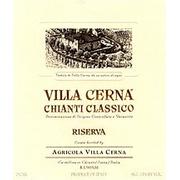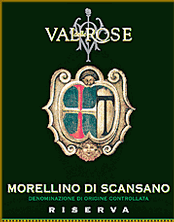Creators Syndicate
It would seem the Italian renaissance in wine is old news. Antinori, Gaja, Banfi, and the wave of so-called “flying” winemakers saw to that. Or so we thought.
Not so fast I say. There are still stories to be told. The once woebegone Bolla is making noise in the north of Italy, and down near the boot of Italy Feudi di San Gregorio has ushered in the rise of the wines of the south. Sicily, an island unto itself, has witnessed a generational change in winemaking and finally caught up to the Mainland in quality.
 Then there is Tuscany, ground that has been ploughed and ploughed again as the rules of the game have changed. Tuscan producers have had it relatively easy through the years because Chianti once stood for quality in Italian wine. That was until the visionary Piero Antinori demonstrated what quality truly meant, what it looked like, and most of all what it tasted like.
Then there is Tuscany, ground that has been ploughed and ploughed again as the rules of the game have changed. Tuscan producers have had it relatively easy through the years because Chianti once stood for quality in Italian wine. That was until the visionary Piero Antinori demonstrated what quality truly meant, what it looked like, and most of all what it tasted like.
As the bar was raised, many Tuscan producers were left behind. The smart ones, however, understood that as more was expected they would not be able to compete unless they upped their game. The house of Cecchi, under the leadership of fourth-generation winemaker Andrea Cecchi, got it.
The family winery, with its Villa Cerna estate in Castellina-in-Chianti in the heart of the Chianti Classico region, and its Val delle Rose property in Scansano, in the much warmer Tuscan district known as the Maremma, and a few smaller properties, has steadily moved forward on the quality front over the past decade or more. The results of Cecchi’s dedication in the vineyards and the cellar are now obvious for all to see, which explains Andrea’s recent presence on a tour of the United States.
He was here for the Gambero Rosso “Tre Bicchieri” tastings, a series of exhibitions to show off all of the Italian wines that had been awarded tre bicchieri, three glasses, in the publication’s most recent annual ranking of Italian wines. Gambero Rosso is Italy’s equivalent of The Wine Spectator, the widely watched U.S. wine publication that generates quite a buzz each year with its list of the Top 100 wines of the year.
Where The Wine Spectator ranks wines on a 100-point scale, Gambero Rosso issues one, two or three bicchieri for its recommended wines (most wines, it should be noted, receive no bicchieri from Gambero Rosso). Cecchi’s 2008 Villa Cerna Chianti Classico Riserva was Andrea’s ticket to the Gambero Rosso tour this year, and the tre bicchieri was a well-deserved kudo for a superb Chianti from a house that hasn’t always done so well.
 The Cecchi wines were once renowned for their earthy, rustic quality, and they appealed to a dwindling crowd of wine consumers who clung to the sometimes funky flavors and aromas of Chianti made the old-fashioned way, without such modern luxuries as temperature-controlled stainless steel fermentation tanks or a basic understanding of how to control or eliminate bacteria that lives in wine barrels.
The Cecchi wines were once renowned for their earthy, rustic quality, and they appealed to a dwindling crowd of wine consumers who clung to the sometimes funky flavors and aromas of Chianti made the old-fashioned way, without such modern luxuries as temperature-controlled stainless steel fermentation tanks or a basic understanding of how to control or eliminate bacteria that lives in wine barrels.
Andrea has been able to correct those fundamental flaws in the Cecchi wines without abandoning the traditions that helped the family establish its name in the Chianti region more than a half century ago.
Andrea Cecchi has embraced modern winemaking while maintaining allegiance to the indigenous grape varieties of the Chianti district, meaning you can be certain a Cecchi Chianti will be made mostly from sangiovese, the workhorse grape of the region, with a splash of colorino, another indigenous grape. Andrea has resisted the urge to join the crowd that hedges its bets each vintage with cabernet sauvignon or merlot, which have been permitted in the wines of Chianti going on two decades now.
As he crisscrossed the U.S. on the tre bicchieri tour, Andrea kindly took the time to present a number of his wines for my evaluation, an opportunity I relished. I’ve followed the upward trajectory of quality at Cecchi for a number of years, and at prices that seem quaintly modest by today’s inflated standard.
Tasting Notes
Castello Montauto 2011 Vernaccia di San Gimignano, Tuscany, Italy ($17) – There is perhaps no other wine that represents the improvement in winemaking in Tuscany than Vernaccia di San Gimignano. Once upon a time it seemed the Tuscans only cared about their red wines, offering whites that were dull and lifeless, and often brown from oxidation before they were barely a year old. This vintage from Cecchi’s Castello Montauto is a golden straw color, with aromas of fresh citrus and dried fruits. It is fresh and clean on the palate, with mouth-watering acidity and a crisp finish. Rating: 88.
 Val delle Rose 2009 Morellino di Scansano Riserva, Tuscany, Italy ($20) – Scansano is situated in the Maremma, southwest of Montalcino toward the coast of Tuscany. The region is warm, so the sangiovese (called “morellino” in the area) always ripens, and in good years it can be rich and voluptuous, distinctly different from the sangiovese-based wines of the Chianti district. Because the region is tucked away far from any major village or city, the wines were undiscovered until recently, and land has been cheap to purchase compared to the Chianti Classico region and the better areas of Montalcino, where Brunello is made. This Cecchi Val delle Rose property produces exceptional Morellino di Scansano. This vintage is lush and pure, with soft tannins and a rich texture on the palate. Aromas of ripe cherries and spice are appealing and typical of the wine. Tremendous value! Rating: 90.
Val delle Rose 2009 Morellino di Scansano Riserva, Tuscany, Italy ($20) – Scansano is situated in the Maremma, southwest of Montalcino toward the coast of Tuscany. The region is warm, so the sangiovese (called “morellino” in the area) always ripens, and in good years it can be rich and voluptuous, distinctly different from the sangiovese-based wines of the Chianti district. Because the region is tucked away far from any major village or city, the wines were undiscovered until recently, and land has been cheap to purchase compared to the Chianti Classico region and the better areas of Montalcino, where Brunello is made. This Cecchi Val delle Rose property produces exceptional Morellino di Scansano. This vintage is lush and pure, with soft tannins and a rich texture on the palate. Aromas of ripe cherries and spice are appealing and typical of the wine. Tremendous value! Rating: 90.
Villa Cerna 2008 Chianti Classico Riserva, Tuscany, Italy ($24) – This was among my go-to Chiantis over the past year, a sleek, beautifully structured Chianti that is likely to improve over the next three to seven years although more than likely most of it will be drunk long before it reaches its peak. This wine exhibits freshness and richness on the palate, with a spicy nose, nicely integrated tannins and good acidity without the telltale bite for which Chianti is renowned. Notes of black cherry and dried herbs come through in this seamless beauty. Villa Cerna is a single-estate, single-vineyard wine from Castellina, a lovely village situated in the center of the Chianti Classico region between the major cities of Florence and Siena. The vineyards are planted to a number of new clones of sangiovese that have emerged in many trials as superior clones. The proof, as always, is in the bottle. Rating: 94.
Cecchi 2007 Coevo, Toscana IGT, Italy ($58) – Cecchi’s hot-rod “Super Tuscan” is a tip of the hat to the undeniable fact that some so-called international grape varieties, typically merlot and cabernet sauvignon, thrive in the hilly, arid climate of Tuscany. The blend is 50 percent sangiovese with 20 percent merlot, 20 percent petit verdot and 10 percent cabernet sauvignon. The wine is aged in small French oak barrels and it has the decided personality of a Bordeaux-style blend, although the large percentage of sangiovese lends a bit of the Tuscan character (aromas of black cherry, fresh acidity). This vintage exhibits an enticing floral note of violets, with hints of spice, black fruits and supple tannins that deliver a soft mouthfeel that marries nicely with the richness of the fruit. Rating: 91.
Follow Robert on Twitter at @wineguru.
8
